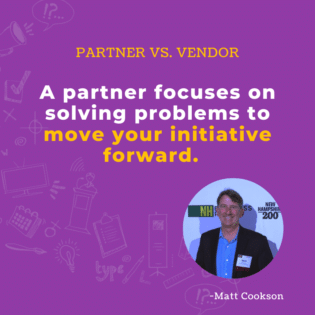To truly get to know someone’s business – to develop a marketing communications strategy and help them move forward – it requires a partnership. When we turned the calendar to a new year and new decade recently. It created an opportunity to reflect back while thinking ahead. When we launched Cookson Communications at the beginning of the last decade, we were coming out of a deep recession, social media was still in its infancy and digital marketing and communications channels were limited.
Fast forward to 2020 and it’s clear that technology has brought on massive changes to how we communicate. However, some things haven’t changed – like telling a good story – which is why it’s critical that you have a partner that works to understand you and your organization and can effectively capture who you are through your marketing, communications, branding and public relations efforts.
From the moment we connect with a prospective client, we ask about their challenges, opportunities and business model. And we talk about the partnership model right up front to help determine if the fit and alignment are good. This is often the inflection point to see if the prospective client is looking for a partner to work closely with or a vendor to manage tasks as assigned. If the fit is there and we agree to work together, my team and I take time to really get to know the client through branding questionnaires, a “deep dive” kick-off session and a discussion about where we want to take the organization over the next few years. This helps us fully capture what the needs are, understand the personalities involved, ensure that expectations are realistic and get a feel for the organizational culture.
Instead of creating a hierarchical relationship, we operate much more effectively when there is a unilateral relationship in which each person feels tied to the outcomes of a project and can freely offer feedback. Looking back, it’s easy to identify when this didn’t exist. As a result, looking for that initial fit is now the utmost priority.
Here are three ways a partner relationship is different from a vendor relationship:

1) A partner isn’t married to an idea.
It’s easy for a creator to feel tied to the creation. But, we’re also realistic. Not everyone can be an Instagram Influencer, YouTuber or can even feel comfortable going live in front of a camera – whether for Facebook or the news – and that’s ok. Part of what makes a partnership work is using our expertise to be a sounding board, support your vision and create a strategy and plan that can make that vision a reality.
2) A partner knows that busy work is a poor substitute for strategy.

It’s easy to see a list of tasks as a measurement of success. But we always ask the hard questions on how a task complements an overall strategy. For example, let’s say a tech company wants to put out a media release announcing that they’re at an industry tradeshow. Could we do it? Absolutely. But the reality is that a company attending or even exhibiting at an industry show isn’t newsworthy. Give it the litmus test – would you read a release like that if you saw the headline? While such an event warrants being in your social feeds, a media release is not the best strategy and should not just be done because you haven’t done one this week (yes, people do say this).
3) A partner focuses on solving problems to move your initiative forward.

Communications and content strategies are holistic – they run across multiple channels with a goal of engagement and having a person act in a certain way – buy, click, vote, comment, etc. In the digital world where we now live, all of this can be measured and tied to results. For example, let’s say your business hasn’t had an updated website in more than five years. The look is stale and clunky. You’ve noticed that your bounce rates and exit rates are high and that your unique visitors have dropped. Sure, a new website can give you a sleek, modern feel, but it’s important to dig into the research (heat maps, keyword analyses, visitor flow) to understand what your site visitors are thinking and doing and make changes based on this critical information. If you are only changing site colors, fonts and pictures to create a fresh look, you probably won’t make any improvements in user experience and those analytics will continue to trend downward.
Over the last decade, plenty has changed, and as marketing communications continues to evolve, we stay on top of trends and industry best practices. As outsourcing of services continues to trend upward, take the time and effort to find a partner that understands your organization and look for a sense of trust. It’s critical that these elements are in place so that you can enjoy the benefits of a long-term partnership that will lead to effective storytelling and moving your vision to reality.
If you aren’t sure where to start, we can help – it’s all about having a conversation and feeling comfortable with the people you might partner with to set your organization up for success over the coming decade.







